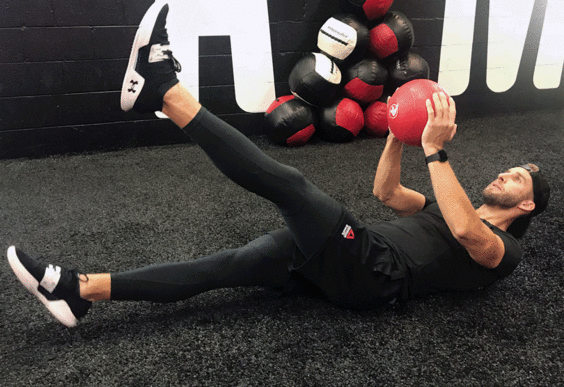Look out, crunches! There’s a new ab sheriff in town. Scissor kicks are a top-notch core exercise that activates multiple muscles at once. Bonus: You can do them at home, or anywhere for that matter.
What are scissor kicks?
Scissor kicks (very similar to flutter kicks) are an exercise in which you engage your core by leveraging the weight of your legs while kicking them like (you guessed it!) scissors ✂️.
Here’s how you can add scissor kicks to your workout routine to strengthen your core.
Scissor kicks are a perf at-home workout move. All you need is a mat or another stable, firm foundation!
Here’s how you do it:
- Lie on your back and extend your legs.
- Keep your arms straight along your body or cross them over your chest.
- Press palms into the floor.
- Push your lower back into the floor and tuck your pelvis.
- Lift both legs to a 45-degree angle and tighten your core.
- Point toes and keep thighs close together.
- Lower one leg at a time until it’s hovering a few inches off the floor.
- Continue for 12–20 reps (6–10 kicks on each leg).
- Take a quick breather before completing another set.
FYI: You shouldn’t do scissor kicks on your bed (even if you have a firm mattress) or any other super soft surface. It can throw your back out of whack.
Scissor kicks are versatile AF. Here are some simple modifications if you’re newer to the #FitFam:
- Place your hands under your lower back for extra stability.
- Let your heels make contact with the floor each time you kick.
- Keep your knees slightly bent. This reduces the intensity on your lower back and core.
To take it up a notch:
- Use ankle weights.
- Crisscross your legs each time you do a rep.
- Add some sit-ups to the mix (it’s INTENSE 🔥).
- Use a resistance band around your ankles or lower legs.
- Slow down your kicks and hold each lift for 3–5 seconds.
Scissor kicks are a bomb way to strengthen and tone core muscles like your:
- obliques
- hip flexors
- rectus abdominis
- transverse abdominis
While your core is the star of the show, scissor kicks also work your:
- quads
- glutes 🍑
- back muscles
- adductors (the upper thigh muscles that attach your pelvis to your thighbone)
Why core exercises are important
A strong core isn’t just about getting a sweet six-pack. You need core strength to do most physical activities, from getting out of bed in the a.m. to running a 5K.
A strong core can also:
- prevent injury
- improve posture
- enhance endurance
- reduce the risk of low back pain
- increase stability and balance
Proper scissor kick form is 10/10 important. Bad form increases your risk of injury and can diminish the results of your sweat sesh.
Here are some tips to keep your scissor kicks safe.
Keep it core-tastic
Make sure you engage your abs throughout the exercise. You might need to tweak your form if you start feeling the burn in your back and not in your abs.
Frankie says relax
Make sure to relax your neck and keep your spine aligned. This helps you engage your core and reduces your risk of a strain or sprain.
Don’t overdo it
Don’t push it to the limit or rush through your workout. This increases your risk of injury. Keep things slow and controlled. And if it hurts, STOP 🛑.
Ixnay if you already have an injury
Since scissor kicks strengthen your core, they can help reduce back pain over time. But you shouldn’t do this workout if you already have:
- neck pain
- lower back issues
- pain in your hip flexors
What if you’re preggo?
Scissor kicks are generally considered safe for pregnant peeps during the first trimester. You should avoid any hardcore core exercises in your second and third trimesters.
P.S. Def talk with your doc before you start a prenatal workout routine.
Scissor kicks are a top-tier core exercise. A strong core can improve your stability, endurance, and posture while reducing your risk of injury.
Just keep in mind that you might need to avoid scissor kicks if you’re pregnant or have a preexisting injury. Talk with a healthcare pro about safer exercises for your unique needs.


